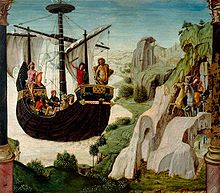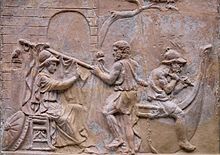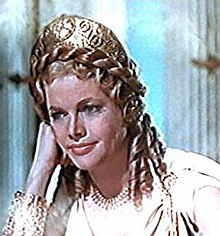Argo


In Greek mythology the Argo (/ˈɑːrɡoʊ/ AR-goh; Ancient Greek: Ἀργώ, romanized: Argṓ) was a ship built with the help of the gods that Jason and the Argonauts sailed from Iolcos to Colchis to retrieve the Golden Fleece. The ship has gone on to be used as a motif in a variety of sources beyond the original legend from books, films and more.
Name[edit]
Most accounts name the ship after her builder, Argus. Cicero, the ancient Roman senator and orator suggested that it was named after the "Argives", a term commonly used by Homer for the Greek people of Argos. Diodorus Siculus reported that some thought the name was derived from an ancient Greek word for 'swift', which could have indicated that the ship was designed to move quickly.[1][2]
The adjective, occasionally found,[3] is Argoan /ɑːrˈɡoʊən/,[4] from Greek Ἀργῶος through Latin Argōus.[5]
Legend[edit]
Construction of the Argo[edit]

The Argo was constructed by the shipwright Argus, and its crew were specially protected by the goddess Hera. The best source for the myth is the Argonautica by Apollonius Rhodius. Argus was said to have planned or constructed the vessel with the help of Athena. The ship was built for travel in the open sea and designed to move quickly with the assistance of a sail. Apollodorus stated the ship had fifty oars, all of which were manned by the Argonauts.[6] His description of the boat would place it as a forerunner or early version of a boat type that became known as a penteconter.
The boat was built with a variety of wood from around the region of Greece. In Medea, Euripides mentions the oars were made from pine trees around Mount Pelion.[7] Catullus later mentioned the boat was made out of fir-wood.[8] The prow of the ship was also made with a special piece of oak from Dodona, an area sacred to Zeus. The oak was said to be able to speak with a human voice and could tell oracles.[9]
According to Apollodorus and Catullus, the Argo was the first ship to sail the seas and was favored by the gods.[10] The god Dionysius did not call the Argo the first ship, but rather a well crafted vessel.[11] Some sources state that since people had not seen a ship before they described the Argo as a monster.[10]
The Argo was built in Thessaly around the area of Mount Pelion.[12] Sextus Propertius claimed it departed from the port of Pagasa.[13]
The Voyage of the Argo[edit]
It was Athena who taught Tiphys to attach the sails to the mast, since he was the steersman and would need to know the workings of the ship.[14] Other sources say he had previously been a sailor along with two other members, which is why he was chosen to steer the boat.[11] Lynceus was also said to have helped guide the ship because he had great sight during night and day.[10]
The ship carried enough supplies, such as vases holding water, for the collective crew and lasted four days before having to refuel.[15] Other items, such as a bronze tripod, were carried aboard. Herodotus claimed the bronze tripod was given to Triton after the Argonauts got lost in Lake Tritonis and needed assistance.[16] It was said the boat had to be carried over land for 12 days to get back on course.[17]
The Argo was said to be loved by the Nereids, who alongside Triton helped guide the ship at dangerous times in the Argonauts' journey.[18]
The Argo after the journey[edit]

After her successful journey, Argo was consecrated to Poseidon in the Isthmus of Corinth. Because the ship was a sacred item, having been made with the help of the gods, she was made into a monument as well as being dedicated to the gods.[12] Years later, a beam fell from the top of the ship and killed Jason while he was asleep on the ground.[19] He was then translated into the sky and turned into the constellation Argo Navis.[20]
The Argo in other sources[edit]
The Argo was a well recognized motif in ancient Greece and has been used in plays, movies, books, philosophical writings and more. Several authors of antiquity (Apollonius Rhodius, Pliny,[21] Philostephanus) discussed the hypothetical shape of the ship. Generally she was imagined like a Greek warship, a galley, and authors hypothesized that she was the first ship of this type that had gone out on a voyage on the high seas.[20] Aristotle used the ship as an example to talk about ostracism in Athens, specifically remarking that the ship left Heracles behind because he was too heavy.[22]
1963 version of the Argo in the movie Jason and the Argonauts[edit]
The version of the Argo that appears in the 1963 film Jason and the Argonauts was modeled after a Greek warship, with shields lining the side of the boat. On either side of the boat are rowers, who are directed how to row through the drumbeat of a leader. A red sail with the head of the golden ram marks the goal of their journey. Besides its practical purposes, the ship is also decorated with ancient motifs, such as eyes on the front of the ship at the water level.

The sacred oak of the ship is here represented as the head of a woman with partial extending wings making up the stern of the ship. The painted head is modeled on the goddess Hera in the movie (played by Honor Blackman) and has the ability to speak to Jason throughout the movie. Argus, the ship builder, said he was inspired to add that feature to the boat when creating it. Filmmakers gave this head the practical effect of being able to open and close its eyes when speaking to Jason.[23]
See also[edit]
References[edit]
- ^ Lemprière, John (1825). "A Classical Dictionary: Containing a Copious Account of All the Proper Names Mentioned in Ancient Authors".
- ^ Diodorus (Siculus) (1814). "The Historical Library of Diodorus the Sicilian: In Fifteen Books. To which are Added the Fragments of Diodorus, and Those Published by H. Valesius, I. Rhodomannus, and F. Ursinus".
- ^ e.g. Robert Cooper Seaton (1912), Rhodius Apollonius: The Argonautica, p. 339
- ^ Noah Webster (1832) A Dictionary of the English Language
- ^ Argo. Charlton T. Lewis and Charles Short. A Latin Dictionary on Perseus Project.
- ^ Apollodorus (1921). The Library with an English Translation by Sir James George Frazer. London: Harvard University Press. pp. Chapter 9, Section 1.
- ^ Euripides. Medea (Euripides with an English translation by David Kovacs). Cambridge: Harvard University Press. pp. Lines 1-48.
- ^ Catullus, Carmina Valerius (1894). Carmina (translated by Sir Richard Francis Burton. London. pp. Poem on Marriage of Peleus and Thetis.
- ^ Warner, Rex (1967). The Stories of the Greeks. USA: Farrar, Straus, and Giroux, Inc. p. 57.
- ^ a b c Curtius, Ernst Robert (2015). "The Ship of the Argonauts". Essays on European Literature. 10.1515.97: 465–496.
- ^ a b Jackson, Steven (1997). "Argo: The First Ship?". Rheinisches Museum für Philologie. Neue Folge. 140 (3/4): 249–257. JSTOR 41234283 – via JSTOR.
- ^ a b P. Ovidius Naso (1813). Commentary on the Heroides of Ovid. London. pp. Hypsipyle Jasoni lines 3-6.
- ^ Sextus Propertius (1995). Elegies (translated by Vincent Katz). Los Angeles: Sun and Moon Press. pp. Addressed to Gallus.
- ^ "The Argo". Jason and the Argonauts. Retrieved 2016-04-10.
- ^ Sleeswyk, Andre Wegener; Meijer, Fik (January 1998). "The Water Supply of the Argo and Other Oared Ships". The Mariner's Mirror. 84 (2): 131–138. doi:10.1080/00253359.1998.10656684.
- ^ Herodotus; Strassler, Robert B.; Purvis, Andrea L. (2009). The landmark Herodotus : the histories. New York: Anchor Books. ISBN 978-1-4000-3114-6. OCLC 264043716.
- ^ How, W. W.; Wells, J. (1991). A commentary on Herodotus with introduction and appendixes. Oxford [Oxfordshire]: Oxford University Press. ISBN 0-19-814384-2. OCLC 18558958.
- ^ Conington, John (1876). Commentary on Vergil's Aeneid, Volume 1. London: Whittaker and Co. pp. Lines 144.
- ^ Euripides; Murray, Gilbert (1912). The Medea. Translated into English rhyming verse with explanatory notes by Gilbert Murray. Robarts - University of Toronto. New York Oxford University Press. pp. 77–78, 96.
- ^ a b
 This article incorporates text from a publication now in the public domain: Chambers, Ephraim, ed. (1728). "Argo". Cyclopædia, or an Universal Dictionary of Arts and Sciences (1st ed.). James and John Knapton, et al. p. 132.
This article incorporates text from a publication now in the public domain: Chambers, Ephraim, ed. (1728). "Argo". Cyclopædia, or an Universal Dictionary of Arts and Sciences (1st ed.). James and John Knapton, et al. p. 132.
- ^ Hist. Nat. 1.c.56
- ^ Aristotle (1944). Politics (Aristotle in 23 Volumes translated by H. Rackham). London: Harvard University Press. pp. Book 3, Section 1284a.
- ^ Chaffey, Don, director. Jason and the Argonauts. Columbia Pictures, 1963.
